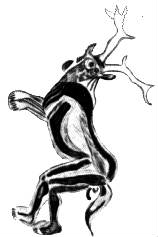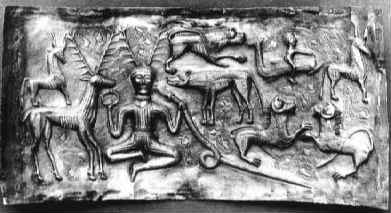|
|
Johfra’s Witches’ Portraits and Sabbaths appeared at a time when there was a resurgence of interest in Wicca, Magick, and Neo-Paganism. The impetus for this resurgence began with Margaret Murray’s books The Witch Cult in Western Europe (1921) and The God of the Witches (1933) as well as Gerald Gardner’s novel, High Magic's Aid (1949). In the 1960’s, that interest exploded, and has since spread through Europe and North America as a serious spiritual practice. Much of the imagery in Johfra’s Pantheist works may be elucidated by Wicca.
|

THE GREAT MAGICIAN
OF TROIS FRERES

THE GAULIC GOD
CERNUNNOS
|
In her pioneering studies, Murray examined the testimony given by the accused during the witch trials and concluded that, beyond the stock answers prompted by the Malleus Malificarum (the inquisitor’s manual) and extracted under torture, there lay a substratum of genuine beliefs which some women willingly put forth and defended to the death. These beliefs were typical of agrarian societies, and stemmed from ‘the old religion’ that had survived underground while Christianity triumphed.
This Pagan religion involved fertility rites timed by the seasons and the moon. Murray found no evidence of a Fertility Goddess, though women participated equally with men in the rites.
|
|
|
|
|

THE HORNED FIGURE FROM THE GUNDESTRUP CAULDRON
|
Instead, she found much evidence for the worship of ‘the Horned God’, which the Inquisition naturally took to be the devil. “The God of the old religion becomes the Devil of the new," Murray quoted.
She went on to cite examples of Horned Gods in agrarian societies, going back as far as the Paleolithic era and the ‘Great Magician’ from the Caverne des Trois Frères in Ariège. She also mentions Pan of ancient Greece and Cernunnos of the Gauls (whose name means simply ‘The Horned One’). All of these gods appealed to farmers and landworkers because they manifest the fertile forces in Nature.
In A History of Religious Ideas (vol II, par 171), Mircea Eliade also notes the similarity between Cernunnos and the ‘Great Magician’ of Trois Frères, going on to compare them with a horned figure from the Gundestrup cauldron. All of these ‘horned gods’ (or their acolytes) possess the antlers of a stag. Eliade remarks that, “because of the periodical renewel of its antlers, the stag is one of the symbols of continual creation.”
Like the fields which stagnate in the Fall and regenerate in the Spring, the antlers of the Horned God manifest the fertile forces of Nature as they undergo death and regeneratiton. The continuous cycle of the moon also manifests this phenomenon.
|
|
|
|


